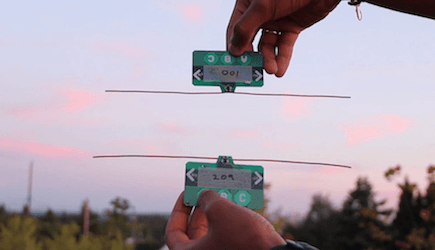Battery-free Communication Devices Harvest Energy from Ambient Radio Signals
August 22, 2013
on
on

A wireless communication device without a dedicated power source has emerged from the Networks and Wireless lab of the University of Washington. The prototype leverages existing radio signals both as a medium of communication and a source of power.
The vision of the Internet of Things is a world populated with networked devices communicating with each other and their owners. True ubiquitous computing isn't limited to adding a little data crunching capacity to electronic devices like fridges, doors and lights but extends to augmenting objects which previously needed no power source with information and communication technology.
To outfit all these objects with batteries adds weight, cost and isn't particularly environmentally friendly. Plus, the task of charging or replacing the batteries of millions of deployed devices would require a dedicated workforce all on its own.
To address this problem, computer engineers of the University of Washington have developed a method to harness TV, WiFi and cellular signals to power small communication devices.
The novelty lies not so much in harvesting energy from ambient radio signals -this has been done before- but rather in the ability to use this limited amount of power to transfer data.
RF energy harvesting yields up to hundreds of microwatts, enough to power a small computing device. It isn't sufficient, however, to generate a radio signal. Instead, devices communicate by reflecting existing signals.
The Washington team has dubbed this new form of data transfer ambient backscattering. The battery-free device sends data to the receiver by either reflecting (backscattering) an ambient signal to signify a one or absorbing it to indicate a zero.
To proof their concept the team built credit card-sized prototypes using off-the-shelf parts which harnesses TV signals. The battery-free devices are capable of transferring 1kbps over 75 centimeters outdoors and 45 centimeters indoors. A specifically designed integrated circuit would reduce size and improve results.
The team published their findings in the paper: Ambient Backscatter: Wireless Communication Out of Thin Air.
Via: Technology Review
The vision of the Internet of Things is a world populated with networked devices communicating with each other and their owners. True ubiquitous computing isn't limited to adding a little data crunching capacity to electronic devices like fridges, doors and lights but extends to augmenting objects which previously needed no power source with information and communication technology.
To outfit all these objects with batteries adds weight, cost and isn't particularly environmentally friendly. Plus, the task of charging or replacing the batteries of millions of deployed devices would require a dedicated workforce all on its own.
To address this problem, computer engineers of the University of Washington have developed a method to harness TV, WiFi and cellular signals to power small communication devices.
The novelty lies not so much in harvesting energy from ambient radio signals -this has been done before- but rather in the ability to use this limited amount of power to transfer data.
RF energy harvesting yields up to hundreds of microwatts, enough to power a small computing device. It isn't sufficient, however, to generate a radio signal. Instead, devices communicate by reflecting existing signals.
The Washington team has dubbed this new form of data transfer ambient backscattering. The battery-free device sends data to the receiver by either reflecting (backscattering) an ambient signal to signify a one or absorbing it to indicate a zero.
To proof their concept the team built credit card-sized prototypes using off-the-shelf parts which harnesses TV signals. The battery-free devices are capable of transferring 1kbps over 75 centimeters outdoors and 45 centimeters indoors. A specifically designed integrated circuit would reduce size and improve results.
The team published their findings in the paper: Ambient Backscatter: Wireless Communication Out of Thin Air.
Via: Technology Review
Read full article
Hide full article


Discussion (3 comments)